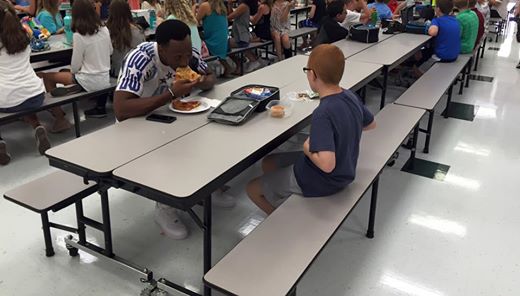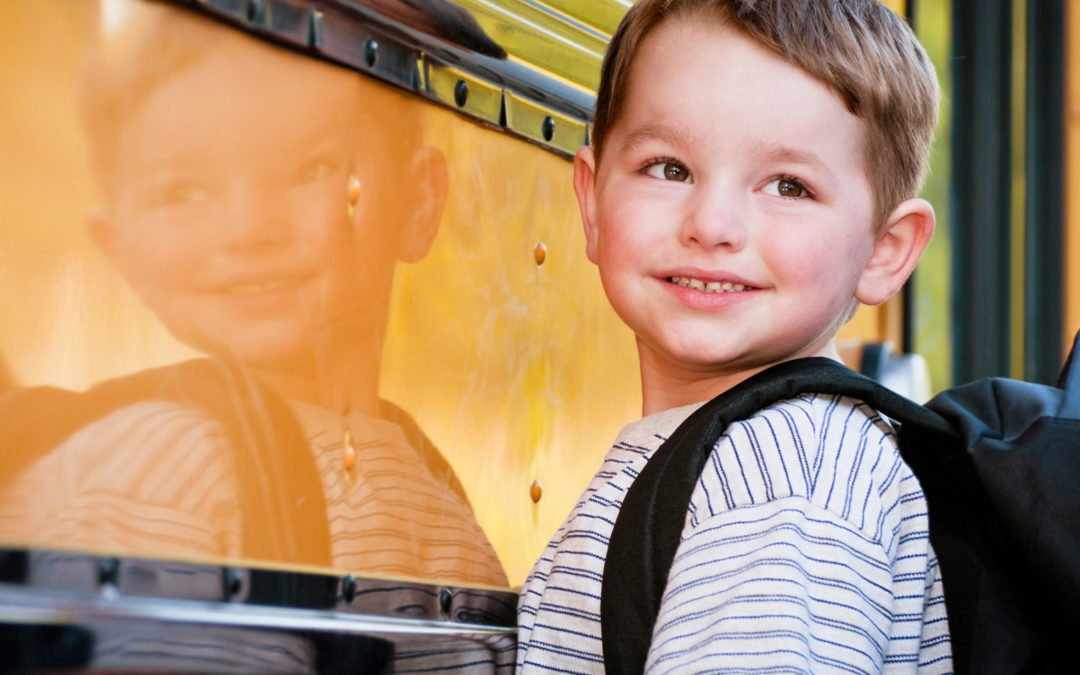
by North Shore Child & Family Guidance Center | Sep 6, 2018 | Blog
September marks the start of another new school year and, for football diehards, it’s also the kickoff to a new season. The flowing together of the two brings to mind the moving story of former Florida State University (FSU) wide receiver Travis Rudolph and Bo Paske, a sixth grade boy with autism.
At the start of the school year in 2016, Rudolph and several teammates visited Montford Middle School in Tallahassee, located near the FSU campus. When Travis spotted 11-year-old Bo sitting alone in the cafeteria, he walked over with his slice of pizza, joined him, and struck up a conversation.
Travis’ simple act of kindness drew national attention when a photo of the two sitting across from one another went viral. Bo described the lunch as “kind of like me sitting on a rainbow.” Travis remarked: “A lot of people give me credit for doing what I did, even though I just see it as that is me.”
Bo told Travis that he was a big FSU fan. The two of them stayed in touch after their first encounter.
Leah Paske, Bo’s mom, wrote about it on Facebook: “Several times lately I have tried to remember my time in middle school. Did I have many friends? Did I sit with anyone at lunch? Just how mean were kids really? Now that I have a child starting middle school, I have feelings of anxiety for him, and they can be overwhelming. Sometimes I’m grateful for his autism. That may sound like a terrible thing to say, but in some ways I think, I hope, it shields him. He doesn’t seem to notice when people stare at him when he flaps his hands. He doesn’t seem to notice that he doesn’t get invited to birthday parties anymore. And he doesn’t seem to mind if he eats lunch alone.”
She went on to say, “A friend of mine sent this beautiful picture to me today and when I saw it with the caption ‘Travis Rudolph is eating lunch with your son’ I replied ‘Who is that?’ He said ‘FSU football player,’ then I had tears streaming down my face. I’m not sure what exactly made this incredibly kind man share a lunch table with my son, but I’m happy to say that it will not soon be forgotten. This is one day I didn’t have to worry if my sweet boy ate lunch alone, because he sat across from someone who is a hero in many eyes.”
Difference and inclusion are terms that are increasingly in vogue in today’s public schools. Growing numbers of children who were previously separated in special education classes and schools are being integrated into the “mainstream” in order to reduce costs and provide less restrictive environments for learning and social-emotional development.
Labeled children, particularly as they approach adolescence, are often objectified, devalued, isolated and ridiculed by their peers. Objectification robs individuals of their humanity. In such relationships the different child simply becomes “the other,” the one too often left out in the cold.
In an era when there seems to be no shortage of awful stories generating from college campuses, the story and photo of Travis and Bo is a breath of fresh air. Henry James said that “a good story is both a picture and idea, and that the picture and the idea should try to be interfused.”
The picture of Travis joining Bo at the lunch table tells us that a simple act of kindness can go a long way to making a difference in someone’s life. We learned from Travis that what it takes is just a little effort—and an abundance of heart.
Note: This article first appeared in Anton Media.

by North Shore Child & Family Guidance Center | Aug 29, 2018 | Blog
Seeing grandparents walking hand in hand with their grandchildren is a heartwarming sight. But our usual assumptions about the relationship may be inaccurate. While we tend to believe that the grandparents are probably spending a few hours babysitting the kids, more and more are the primary caregivers, with their grandchildren as their full-time responsibility.
A July 2018 research update from the Butler Center for Research cites the most recent figures available from the U.S. Census, which indicate that in 2016, 2.5 million grandparents were responsible for the basic needs of one or more grandchildren under 18 years old living with them. Nearly 6 million children under 18, with 2.6 million of those under age 6, were living in their grandparents’ household.
Why the increase? Although this isn’t a new phenomenon—one prominent example is President Barack Obama, who was raised largely by his grandparents—part of the reason the figures have risen is believed to be a result of the opioid epidemic. According to the CDC, drug overdose deaths in the United States have more than tripled from 1999 to 2015, and often leave children parentless.
Other factors include incarceration, death of a parent or parents, or child abuse.
There are many concerns for these grandparent caregivers, including economic problems, as well as emotional factors, says Dr. Nellie Taylor-Walthrust, Director of the Guidance Center’s Leeds Place. “These grandparents are often isolated, struggling with health and financial issues that add additional stress to the total family,” she says.

[Source: U.S. Census Bureau]
To serve local grandparents who are in this situation, the Guidance Center created a program called C-GRASP, which stands for Caregiver Grandparent Respite and Support Program. Through C-GRASP, we provide support and education for grandparents who are the primary caregivers of their young grandchildren.
“Through partnerships with a team of supportive local entities, we provide the grandparents with a variety of services, including respite and peer support activities, counseling, clothing, food, housing assistance, transportation and school advocacy,” says Dr. Taylor-Walthrust. “Those grandparents who take part in C-GRASP feel supported by the services they receive that are designed to meet their individual needs. They also have the opportunity to develop a social network with other grandparents who are experiencing the same life challenge.”
To learn more about C-GRASP, contact the Guidance Center at (516) 626-1971.
Sources:
https://www.hazeldenbettyford.org/education/bcr/addiction-research/grandparents-raising-grandchildren-ru-718
http://www.pewtrusts.org/en/research-and-analysis/blogs/stateline/2016/11/02/why-more-grandparents-are-raising-children
https://theconversation.com/why-more-grandparents-are-raising-their-grandchildren-83543

by North Shore Child & Family Guidance Center | Aug 21, 2018 | Blog
Curing the Kindergarten Jitters
It’s National Get Ready for Kindergarten month. If you’re a parent with a child who is about to head to “big kid” school for the first time, you may be faced with an anxious little one—plus you may have some jitters yourself!
According to Dr. Sue Cohen, Director of Early Childhood and Psychological Services at North Shore Child & Family Guidance Center, starting a new school can be a challenging situation for many children. “There are lots of new people, routines and lessons to be learned,” she says. “But the good news is that there are many things that parents can do to ease this rite of passage.”
If your school allows it, plan to bring your child to their classroom to meet their teacher before the school year begins. Also take them to see the gym, the playground, cafeteria, library, nurse’s office, etc.
“Call the school now to set up a time to visit, even if the teacher won’t be available,” says Cohen. “The unknown is what’s most scary for children, so the more you can familiarize them with the school and the routine, the less worried they will be.”
Help for Cash-Strapped Parents
If purchasing supplies is a financial hardship, help is available. Many churches, community groups and other organizations offer free backpacks and other items on your school shopping list. Here are some places to contact for help:
But be careful not to put your own fears onto your child. “A lot of parents reflect on their own first-day jitters, and they assume their child feels the same way,” says Cohen. “Listen carefully to what they tell you. Let them express all their feelings, which may include fear but also excitement!”
Below are some more suggestions to make the transition as smooth as possible:
- Some schools help set up late summer playground events for incoming kindergartners. If they do, take advantage of the opportunity for your child to meet some new friends.
- Talk about what they are going to learn; make a game of “playing school” by introducing some of the activities that go on in a typical school day.
- Bring them with you when you shop for school supplies. Choosing their own folders, pencils, crayons and the like will make the experience feel special.
- Get your child on a regular bedtime schedule before school begins so they are accustomed to getting up at the same time they’ll need to awaken for school.
- Sit together and make a morning game plan—what are some breakfast ideas, which outfits will they want to wear their first week, and how they will be getting to school. If you can, do some practice runs (or walks) to the bus stop, if they’ll be taking one.
- Teach your child their basic contact information, including the correct spelling of their name, their address and their phone number. Also help them practice writing their own names.
- Make sure they know how to take their shoes on and off, and also how to zip up their backpacks.
Most of all, relax! When you give your children a chance to talk about all of their emotions and react calmly to whatever they say, it reassures them that everything will be alright. “Don’t be upset if they’re not upset,” says Cohen. “They may hop on the bus and do just fine.”
by North Shore Child & Family Guidance Center | Aug 17, 2018 | In The Media
Did you know that every day more than 290 Americans die from suicide or a drug overdose?
With proper treatment, many of these tragedies could be prevented — but despite a law that guarantees coverage, people face enormous roadblocks when they seek care.
In 2008 President George W. Bush signed the landmark Mental Health Parity and Addiction Equity Act (Parity Act).
The Parity Act mandates equal insurance coverage for mental health (MH) and substance use disorders (SUD) as compared to other medical/surgical benefits covered by the plan.
According to its new website parityat10.com, “Parity at 10 seeks to ensure that insurance carriers and state Medicaid programs comply with the law so that consumers can access the evidence-based health care they need and are entitled by law to receive.”
What does equal insurance coverage mean?
It means ending insurer discrimination against access to timely and affordable care including high out-of-pocket costs and shorter lengths of care for MH/SUD.
Parity — which is another word for equity — in this case means that MH/SUD coverage must be provided on par with coverage of medical and surgical care.
Notably, this legislation was the result of a bipartisan effort by Sens. Paul Wellstone, a liberal Democrat, and Pete Domenici, a conservative Republican. What the senators had in common were personal family experiences that motivated their tireless efforts to pass this law.
Parity saves lives. Parity law is a civil rights law that has not been vigorously enforced by the States, which have the primary responsibility for enforcement of private insurance and Medicaid.
One of the most pernicious violations and barriers to care is inadequate networks of MH/SUD providers.
North Shore Child & Family Guidance Center documented this in its 2018 Project Access Study which surveyed 650 Long Island consumers of MH/SUD care. Nearly 50 percent of respondents said that it was easier for them to access medical/surgical care than MH/SUD Care.
Nationally, patients responding to a National Alliance on Mental Illness survey reported being denied twice as often for mental health care as for medical-surgical care under the Affordable Care Act.
The actuarial firm Milliman reviewed claims data in New York and found that patients had to go out-of-network for MH/SUD care far more often than for medical/surgical care — a very expensive proposition that flies in the face of the Parity Act.
At North Shore Child & Family Guidance Center, we are a proud partner of the Parity at 10 Compliance Campaign. On August 10 I attended an inaugural Parity at 10 meeting in Albany with my fellow advocates and top officials in the Cuomo administration.
Some of the details in this column were included in the policy brief provided to Gov. Cuomo. The consensus among the advocates was that insurers do everything in their power to skirt parity.
Another staunch supporter of the original legislation was Patrick J. Kennedy, a former member of the U.S. House of Representatives. Kennedy struggled with mental illness and addiction for most of his life.
In his book “A Common Struggle,” Kennedy said the battle ahead is for the law to be enforced in the face of health insurers who stand to profit by denying the full range of coverage for people living with mental illness and addictions.
Kennedy rightly frames the inequities that people with mental illness and addictions face as a matter of civil rights.
Discriminatory insurance coverage for those with mental health and substance use disorders must end. When insurers do not comply with the law and enforcement is inadequate, millions of Americans are at risk.
Andrew Malekoff is the Executive Director of North Shore Child & Family Guidance Center, which provides comprehensive mental health services for children from birth through 24 and their families. To find out more, visit www.northshorechildguidance.org.
![Welcoming Club Presents Check to the Guidance Center, Long Island Business News, August 10-16, 2018]()
by North Shore Child & Family Guidance Center | Aug 14, 2018 | In The Media, Press Releases
Meg Dockery-Cremins (center) of the Welcoming Club of Garden City presented a $30,000 donation to Lauren McGowan and Andrew Malekoff of North Shore Child & Family Guidance Center.






